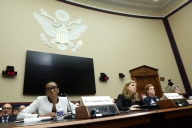You have /5 articles left.
Sign up for a free account or log in.
A federal appeals court last week reversed a decision by a lower court on a student's expulsion.
Julien Endres was dismissed by Northeast Ohio Medical University for allegedly cheating on an exam. Endres contested the accusation, saying that his behavior during the test that put him under suspicion was due to his taking medication for attention deficit hyperactivity disorder.
The U.S. Court of Appeals for the Sixth Circuit ruled Friday that Endres's case would be retried, and that Endres submitted enough evidence to show that his right to due process had been hindered.
Lawyers for neither side could be reached. But the ruling outlines the case in detail.
Following Endres’s dismissal, he sued the university.
The district court earlier ruled Endres’s suit was untimely. The appeals court reversed the earlier decision, maintaining that Endres’s claims were timely.
Endres was diagnosed with ADHD at age six, for which he formerly took Ritalin.
When Endres entered his second semester of his first year of medical school, he began to notice for the first time side effects related to the medication. Endres cited feeling sedated and lethargic due to the drug, so he ceased taking it.
By second semester, he had completed 14 of the 15 required first-year med school courses. Once he stopped taking Ritalin, Endres failed the 15th and last class remaining before he could move into year two.
NEOMED had Endres repeat the entire year, including the 14 classes he did pass.
Coming into fall semester 2015, Endres switched from Ritalin to Strattera, which did not make him drowsy but also was not as effective at suppressing his fidgeting (a common symptom of ADHD).
During one of the exams for the course Human Development and Structure, taught by Professor Hans Thewissen, Endres fidgeted repeatedly.
Tests at NEOMED are taken on special laptops that have certain software that allows for students to zoom in and out of material. Endres states that NEOMED laptop screens are set at the lowest brightness level and that students cannot adjust these settings. Additionally, students are recorded on video and observed by NEOMED officials during the test, both of which are known to students.
During the Sept. 28, 2015 test in Human Development and Structure, Endres was seated directly in front of the camera, and his fidgeting throughout the 25-question test was recorded.
As documented on the video recording, Endres periodically twitched his eyes to the right, appearing to administrators to be glancing at the computer of the student sitting next to him.
After the test, one of the proctors completed an irregularity report noting that while Endres repeatedly looked at the other student’s computer screen, it could be because he was “nervous.”
Following the irregularity report filing to Sandra Emerick, director of academic affairs and student services, the university investigated.
The answer keys for Endres and the student to his right showed that 84 percent of their answers were identical: they both answered the same six questions incorrectly and the same 15 questions correctly.
NEOMED administrators have several options as outlined in the student handbook to address issues such as these. Emerick opted to refer the allegations to the Committee on Academic and Professional Progress.
An Oct. 7, 2015, meeting between Emerick and Endres was the first time Endres became aware of the cheating allegations. Endres was able to review the video recording of the test and described himself as “shell-shocked” upon learning how severe his fidgeting was.
Endres told Emerick that he had just switched ADHD medications two months prior; he was told to provide documentation from his doctor confirming this. Endres was able to provide this less than a week later along with his medical records outlining his ADHD treatment.
Endres’s doctor viewed the recording of the test and informed NEOMED that the fidgeting mimicked behavior that Endres had described in an April 2015 appointment.
After their first meeting, Endres allegedly emailed Emerick requesting a “field test” be done recreating the testing situation to prove that cheating would be “impossible.” According to Endres, Emerick never responded.
During the first CAPP hearing in October, Endres presented evidence in his defense, including a field test he independently conducted, which he said showed that cheating was not possible given the computer setup.
Endres explained that his neighbor student’s zooming in and out of questions caused flashes on the screen, which caught Endres's eye.
Endres also explained that the similarity between his and the other student’s answers was statistically unremarkable.
Throughout Endres's testimony and CAPP’s deliberations, Emerick remained in the room.
The CAPP panel determined Endres was responsible for misconduct. He was contacted the next day and informed of this decision and what his next available steps were.
Endres and his parents then met with Emerick, who revealed to them some of the evidence she had presented during her portion of the hearing. It included the notion that Endres could have used his right hand to shield his eyes from the distracting light flashes, and that two students getting the same six wrong answers was statistically improbable.
Following this new information, Endres requested more evidence including the answer keys and scores for every student in the Human Development and Structure class, and the time stamps for when he and his neighbor student answered questions on their laptops.
After initially declining to provide these materials, NEOMED eventually fulfilled Endres’s request the night before the deadline for his CAPP appeal.
Despite the quick turnaround, Endres was able to supply CAPP with signatures from Human Development and Structure students saying it was not possible to look at other laptop screens, comparisons from hundreds of tests disproving the administration’s statistical analysis, and a psychiatrist’s evaluation of his behavior during the test.
Once again, Emerick was allowed to be present for the entire hearing, while Endres was only present to give his testimony.
Endres was granted a second hearing but was told he could not divulge the statistical probability of two students getting a certain number of the same questions incorrect. Further evidence Endres compiled was also restricted.
Following this, Endres was allowed to review his student file, which he alleges contained information he was not allowed to see prior to his hearing, and a memo from Emerick that falsely characterized conversations she had with Endres’s physicians.
On Nov. 19, 2015, Endres found that the committee had voted to dismiss him.
On Nov. 16, 2017, Endres filed his complaint in federal court. It was later dismissed on the grounds that it was outside the two-year time frame, the argument being that the time frame began in October 2015, when Endres's dismissal first arose. However, the appeals court believed that the time frame actually began in November, after Endres had appealed and was formally and finally dismissed.
Whether Endres did or did not cheat during that Sept. 28 test was irrelevant to this ruling, as it was not the focus of the court at this time.
The case will now go back to the district court, which will review the points addressed by the court of appeals and retry the case.
The appeals court ruled that the Constitution, not the student handbook, set the grounds for dismissal.
The ruling also stated that Endres had provided more than enough evidence to demonstrate that his right to due process had been violated, specifically citing Emerick withholding information from him and his not being allowed to attend her testimony at the hearing.








